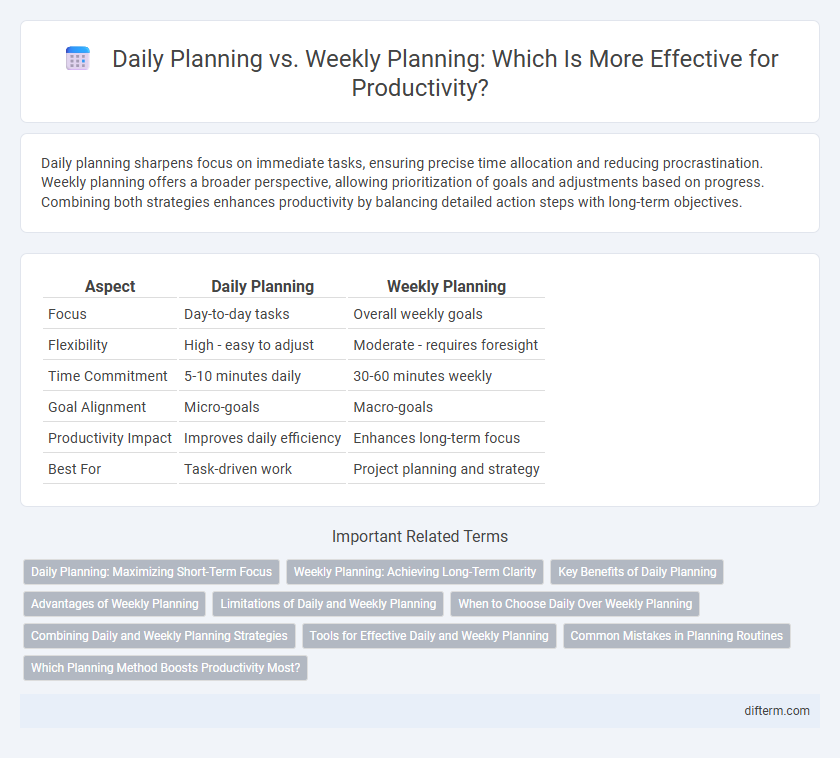Daily planning sharpens focus on immediate tasks, ensuring precise time allocation and reducing procrastination. Weekly planning offers a broader perspective, allowing prioritization of goals and adjustments based on progress. Combining both strategies enhances productivity by balancing detailed action steps with long-term objectives.
Table of Comparison
| Aspect | Daily Planning | Weekly Planning |
|---|---|---|
| Focus | Day-to-day tasks | Overall weekly goals |
| Flexibility | High - easy to adjust | Moderate - requires foresight |
| Time Commitment | 5-10 minutes daily | 30-60 minutes weekly |
| Goal Alignment | Micro-goals | Macro-goals |
| Productivity Impact | Improves daily efficiency | Enhances long-term focus |
| Best For | Task-driven work | Project planning and strategy |
Daily Planning: Maximizing Short-Term Focus
Daily planning enhances productivity by breaking down larger weekly goals into manageable, actionable tasks, enabling sharper focus on immediate priorities. This approach minimizes procrastination and keeps motivation high through consistent progress tracking. Concentrating on daily objectives aligns efforts with short-term outcomes, driving efficient task completion and reducing overwhelm.
Weekly Planning: Achieving Long-Term Clarity
Weekly planning enhances productivity by providing a clear overview of long-term goals and key priorities, enabling strategic time allocation for complex projects and deadlines. This method supports better resource management and reduces stress by anticipating potential obstacles throughout the week. Concentrating on weekly objectives fosters sustained focus, improving efficiency and goal attainment compared to daily planning's short-term scope.
Key Benefits of Daily Planning
Daily planning enhances productivity by providing clear, actionable goals that align with immediate priorities, reducing decision fatigue throughout the day. It increases focus and time management accuracy, allowing individuals to allocate resources effectively and adapt swiftly to changing demands. By breaking tasks into manageable segments, daily planning fosters consistent progress and prevents overwhelm, leading to improved task completion rates.
Advantages of Weekly Planning
Weekly planning enhances productivity by providing a comprehensive overview of tasks and deadlines, allowing for better prioritization and time allocation. It fosters a strategic approach to goal setting, reducing the risk of overlooking important activities that shorter planning cycles might miss. This method also improves flexibility, enabling adjustments based on weekly progress and unforeseen changes.
Limitations of Daily and Weekly Planning
Daily planning often leads to a narrow focus that overlooks long-term goals, causing missed opportunities for strategic adjustments. Weekly planning may result in an overwhelming list of tasks that lack immediacy, diluting daily effectiveness and increasing procrastination risks. Both approaches struggle to balance flexibility and structure, which can hinder adaptability in dynamic work environments.
When to Choose Daily Over Weekly Planning
Choose daily planning when tasks require immediate attention, fast adaptability, or short-term deadlines to maintain high productivity. Prioritize daily planning for dynamic work environments where priorities frequently shift and detailed task management is necessary. This approach enhances focus on urgent activities and prevents overwhelm from long-term schedules.
Combining Daily and Weekly Planning Strategies
Combining daily and weekly planning strategies enhances productivity by providing both immediate focus and long-term vision. Daily planning breaks down weekly goals into actionable tasks, ensuring steady progress and adaptability to changing priorities. Weekly planning offers a structured overview, enabling prioritization and resource allocation to optimize time management and task completion.
Tools for Effective Daily and Weekly Planning
Digital planners like Todoist and Microsoft To Do enhance daily planning by offering task prioritization, reminders, and time blocking features. Weekly planning benefits from tools such as Trello and Asana, which provide visual progress tracking, project management, and collaborative capabilities. Combining both digital and analog tools, including bullet journals and calendars, ensures a comprehensive approach to managing tasks and goals efficiently.
Common Mistakes in Planning Routines
Daily planning often falters due to overly detailed tasks that limit flexibility and increase stress, while weekly planning mistakes include vague goal setting that reduces clarity and accountability. Both approaches suffer from inconsistent review processes, undermining progress tracking and adjustment effectiveness. Effective productivity hinges on balancing detailed daily actions with strategic weekly objectives, supported by regular evaluations to optimize planning routines.
Which Planning Method Boosts Productivity Most?
Daily planning enhances productivity by breaking tasks into manageable, focused segments, allowing for immediate prioritization and quick adjustments. Weekly planning provides a broader perspective, enabling strategic allocation of time for complex projects and reducing last-minute stress. Studies reveal that combining daily task lists within a weekly framework maximizes productivity by balancing short-term focus with long-term goals.
daily planning vs weekly planning Infographic

 difterm.com
difterm.com